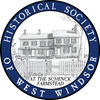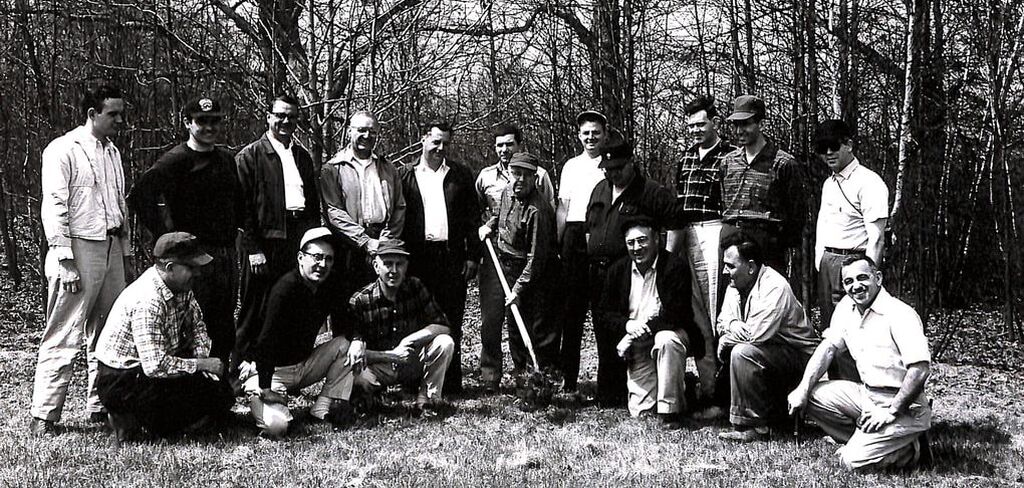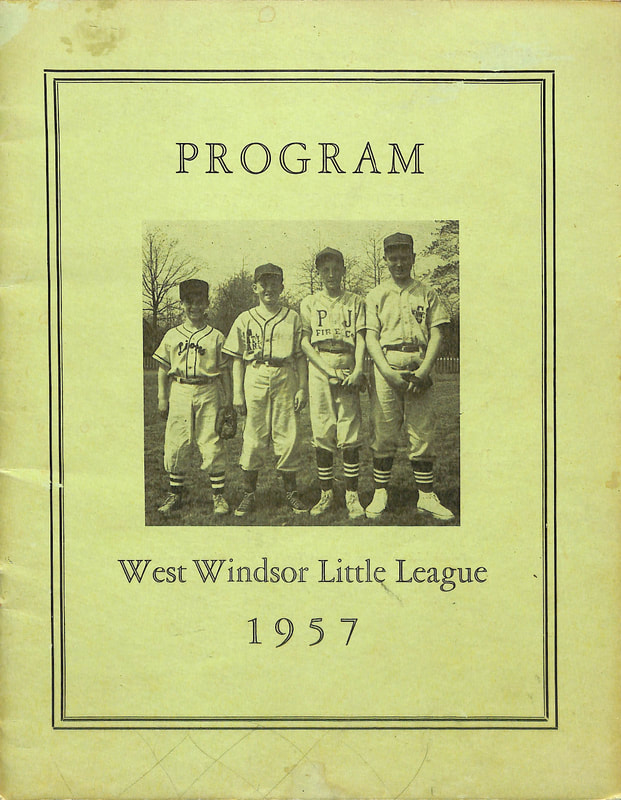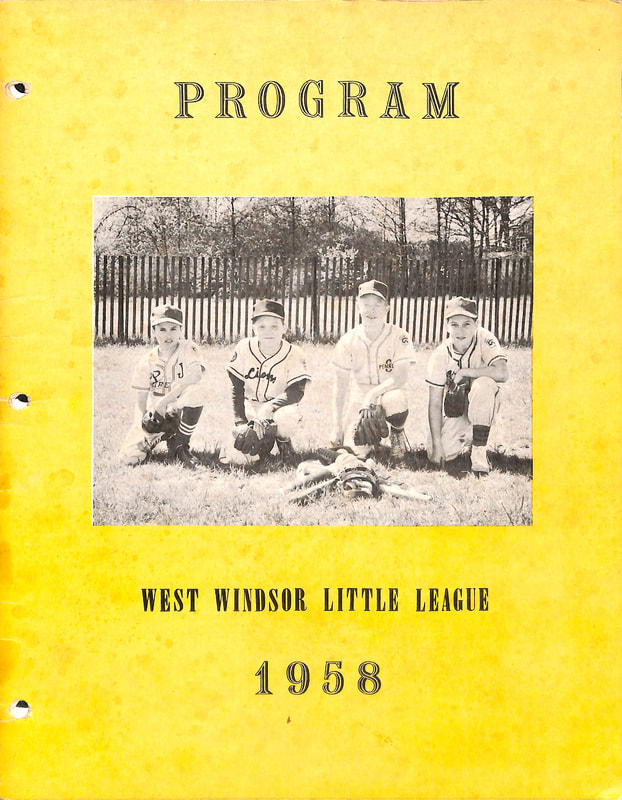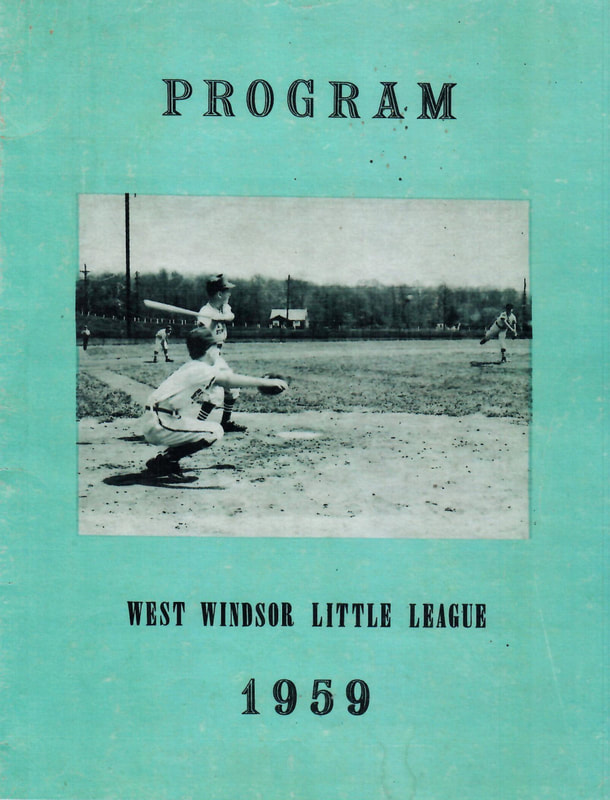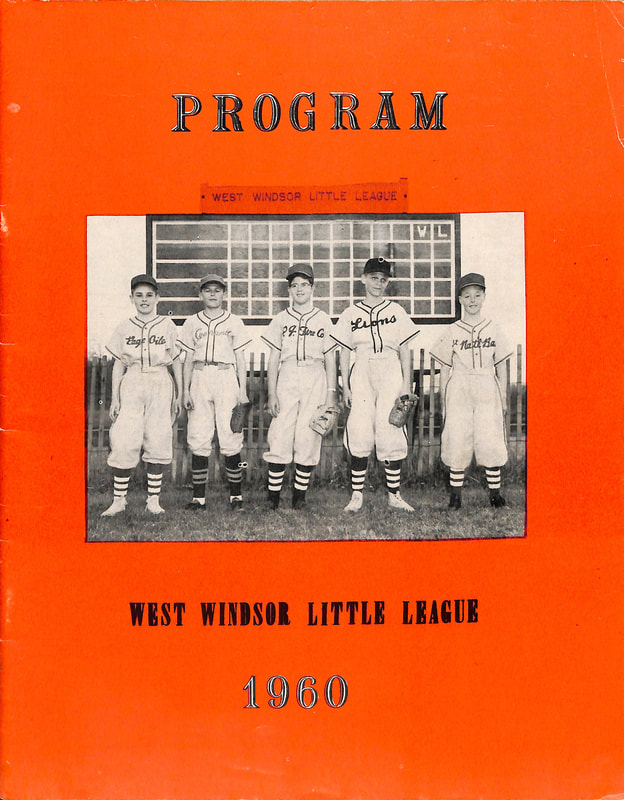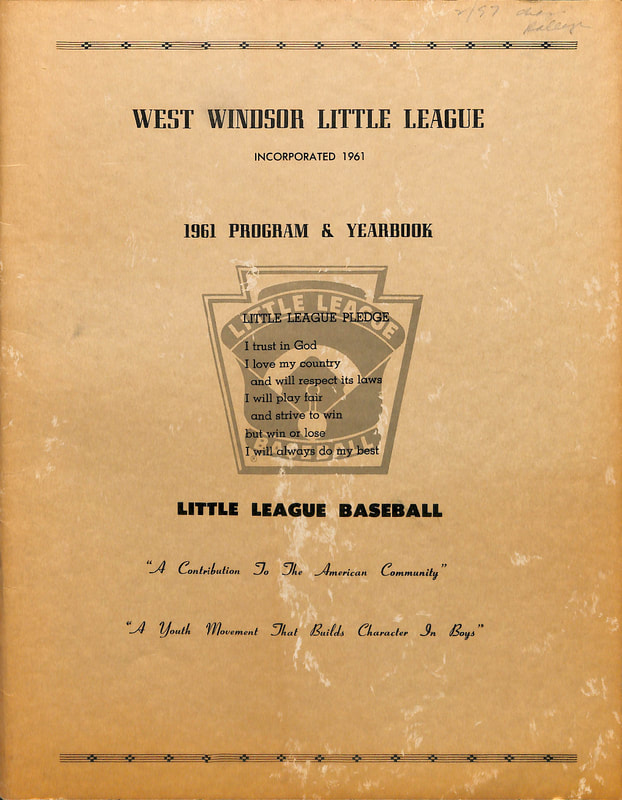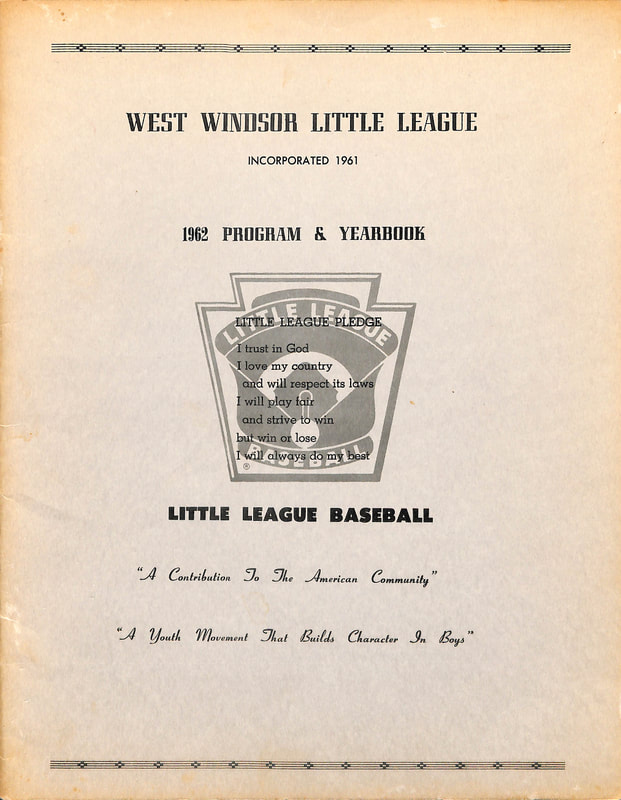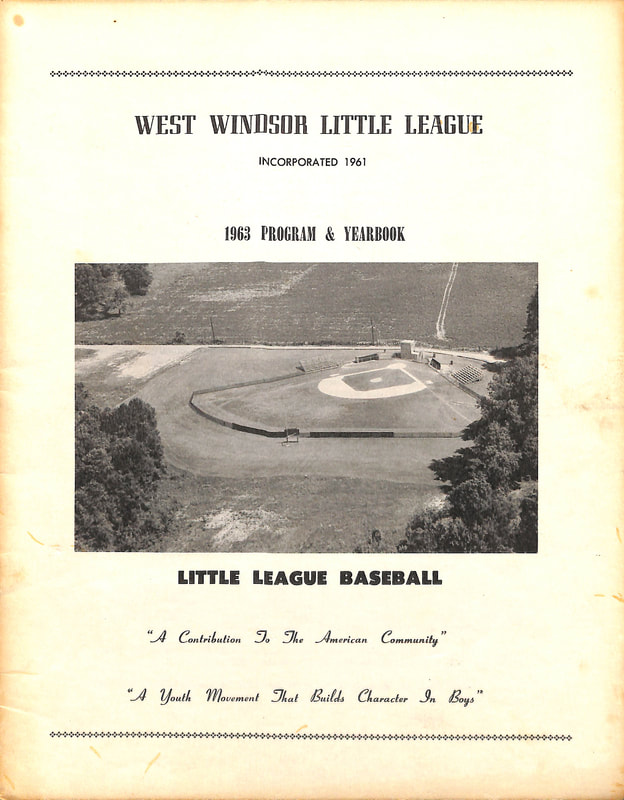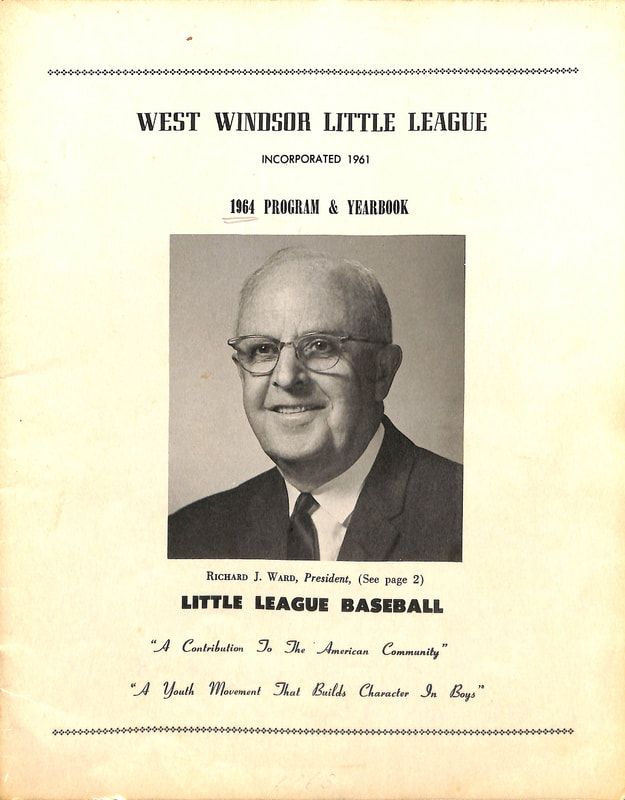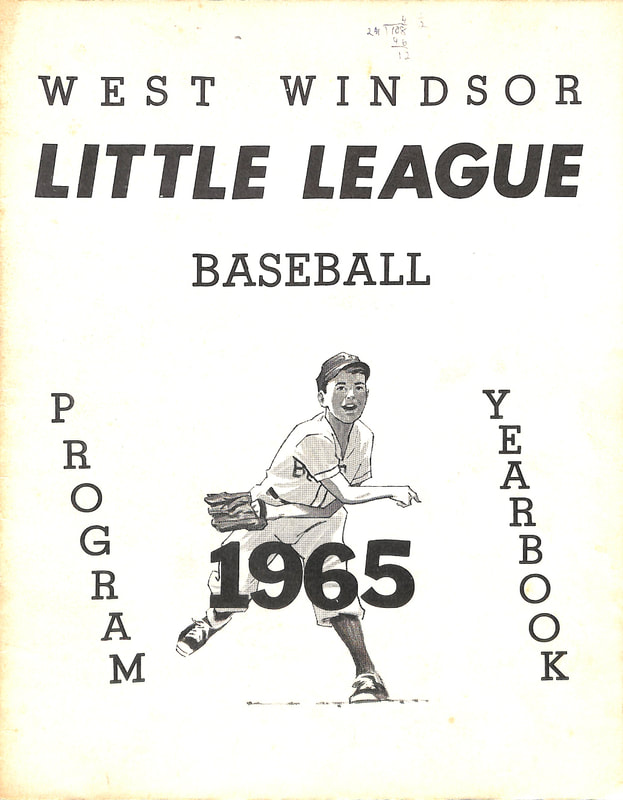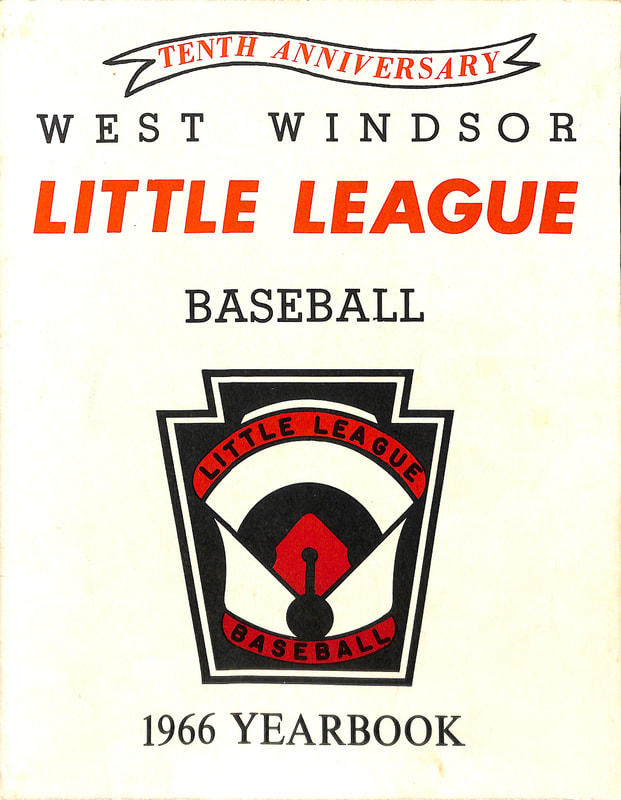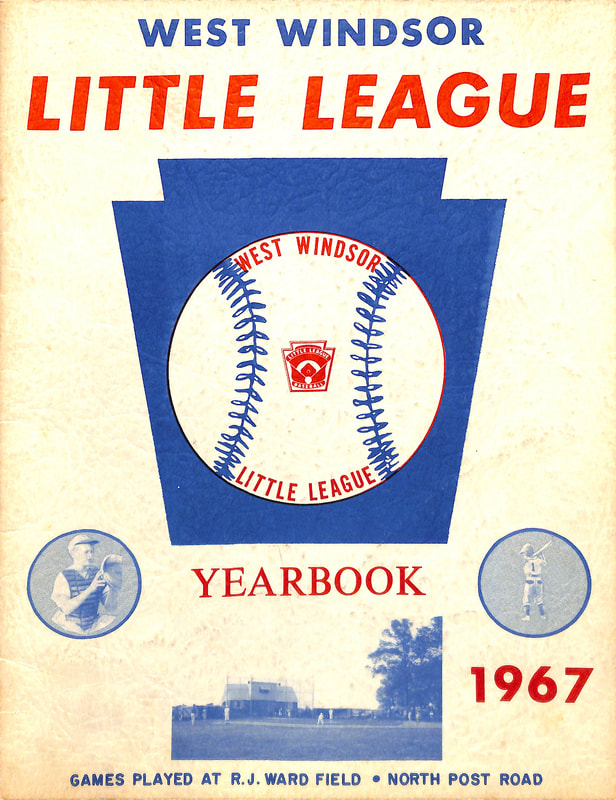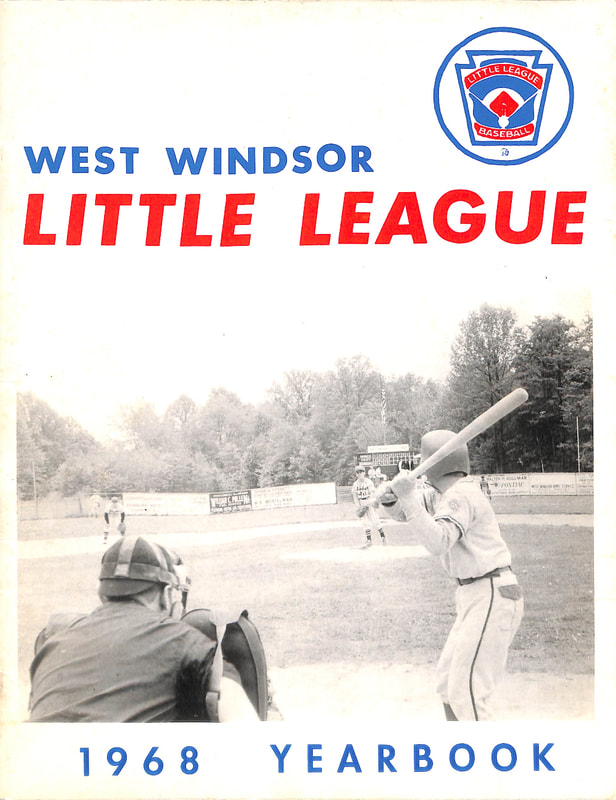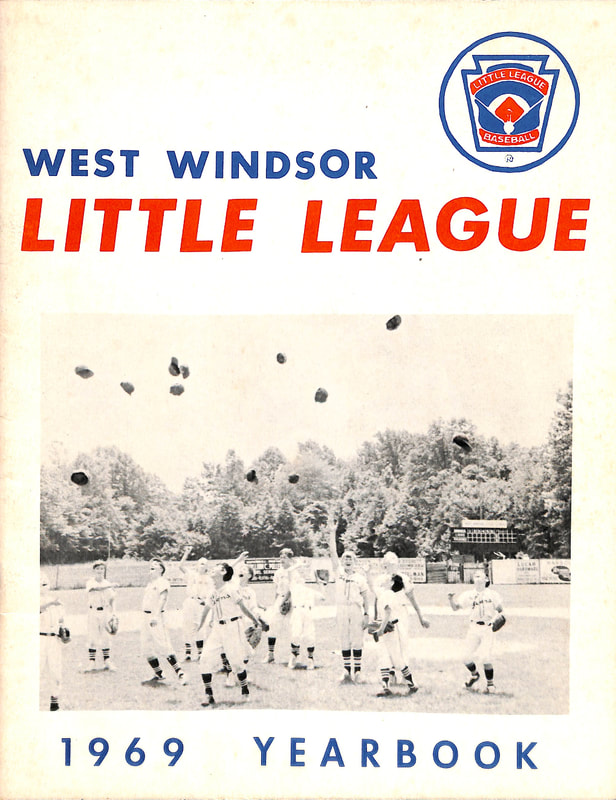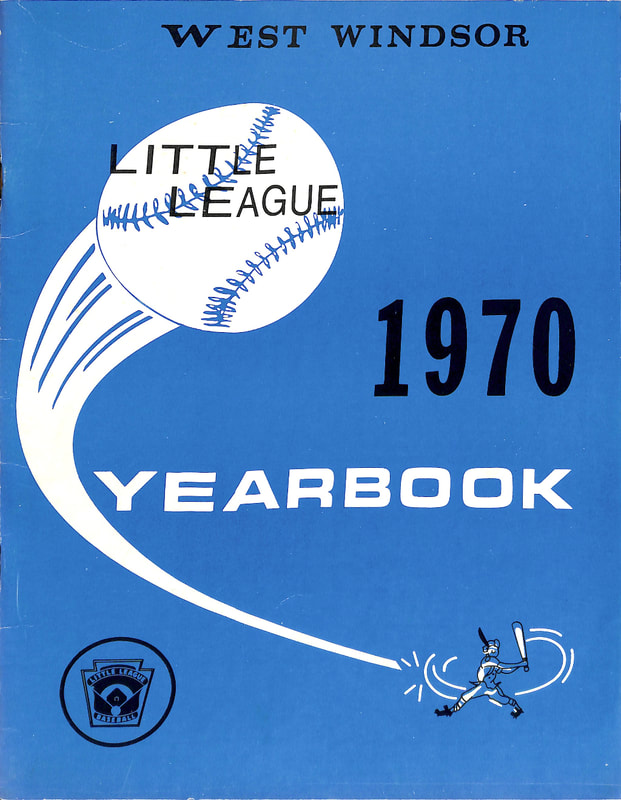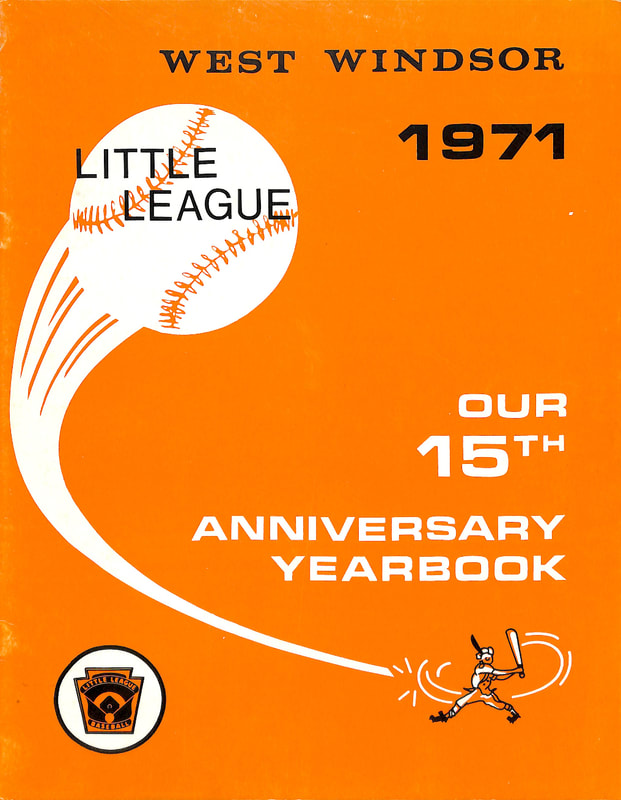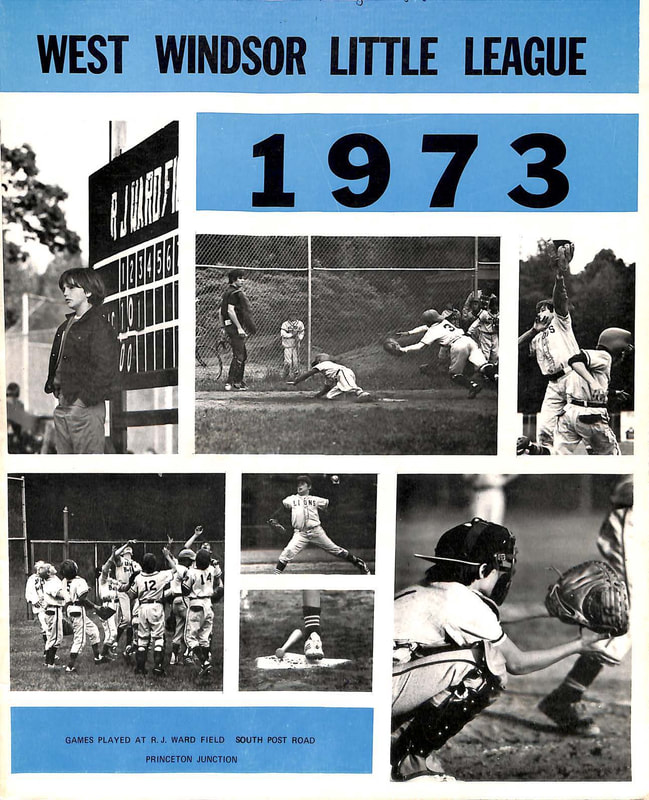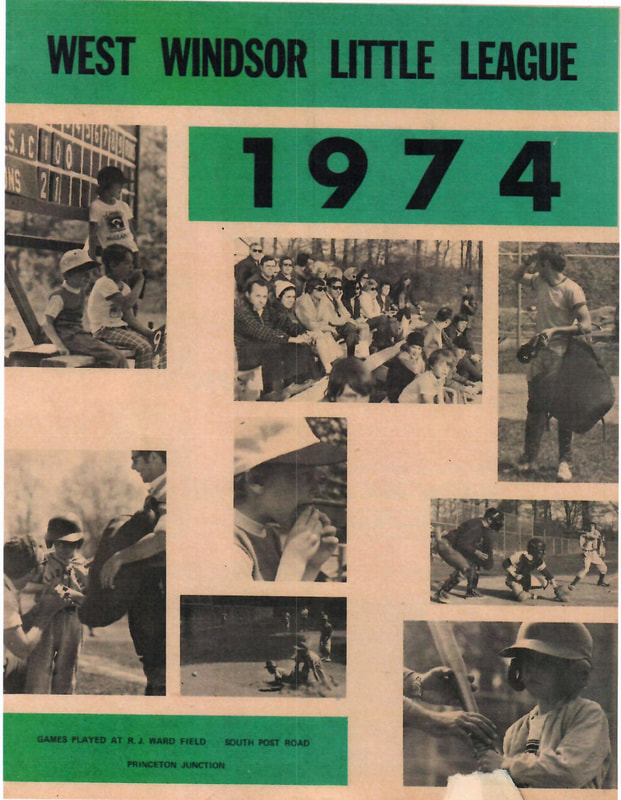West Windsor Little League
Researched and written in 1994 by Joan Parry, whose only connection with the Little League is the love of baseball only a Brooklyn Dodgers fan can have...
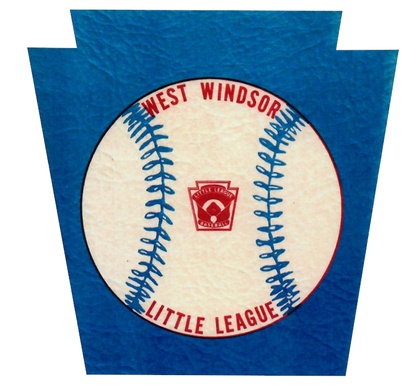 Logo from 1967 LL Yearbook
Logo from 1967 LL Yearbook
Overview
In pre-development West Windsor, baseball was not an organized recreation, but rather casual games among groups of friends and classmates whenever chores, school, and an empty schoolyard allowed. Older residents may recall many games between kids from various West Windsor villages, such as Dutch Neck vs Princeton Junction. Children played in their everyday clothes, using whatever balls, bats, mitts, etc. the group could provide.
In an article in the Summer/Fall 1985 "Broadside" (the Historical Society of West Windsor's seasonal newsletter), local resident Michael Corio recalled baseball games played by local boys at a typical Fourth of July family picnic and swim at the "Sheepwash," a long-abandoned West Windsor recreational area on the Millstone River.
It was not until 1956 that the need for more organized baseball teams and games was realized. The following section consists of excerpts from John Bowker's 10-year history of the Little League (LL) published in the 1966 LL yearbook...
In pre-development West Windsor, baseball was not an organized recreation, but rather casual games among groups of friends and classmates whenever chores, school, and an empty schoolyard allowed. Older residents may recall many games between kids from various West Windsor villages, such as Dutch Neck vs Princeton Junction. Children played in their everyday clothes, using whatever balls, bats, mitts, etc. the group could provide.
In an article in the Summer/Fall 1985 "Broadside" (the Historical Society of West Windsor's seasonal newsletter), local resident Michael Corio recalled baseball games played by local boys at a typical Fourth of July family picnic and swim at the "Sheepwash," a long-abandoned West Windsor recreational area on the Millstone River.
It was not until 1956 that the need for more organized baseball teams and games was realized. The following section consists of excerpts from John Bowker's 10-year history of the Little League (LL) published in the 1966 LL yearbook...
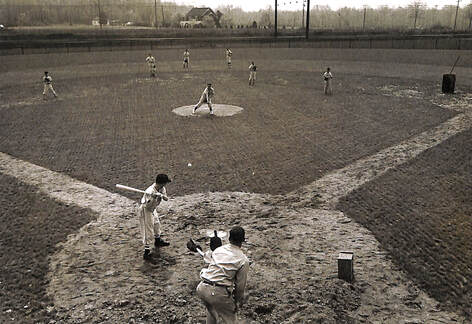 Alexander Road LL field in 1954
Alexander Road LL field in 1954
The First Ten Years - 1956-66
"On this warm summer's evening in June 1966, we are looking out from the press box of the newly-constructed club house and refreshment stand at the Richard J. Ward field of the West Windsor Little League, incorporated. From here, the spacious cinder block dugouts located behind protective fencing along the first and third base lines are momentarily quiet; the American flag has been removed from the pole at the Center Field scoreboard, and the 185-foot outfield markers are barely visible in the waning daylight. Dick Ward, Bill Bleacher, Ray Phillips, and Warren Froehlich have remained behind to piece together the tale of Little League baseball in West Windsor township.
'We had four teams here for several years sponsored by the YMCA before any thoughts of organizing these activities came up locally,' Ray Phillips started. 'It seems that an All Star team of boys had been formed in Plainsboro in 1956 and, according to their press releases, they were invincible! Some of the local boys found this hard to believe and were anxious to answer the challenge, but pointed out that they would be playing in brightly colored tee shirts and old caps if something weren't done about it.'
The West Windsor Lions Club, stimulated by Ray Phillips, purchased the needed uniforms and the new West Windsor Lions Baseball Team for Boys was ready to play! No record of the wins of our local team has been maintained. During the fall of 1956, cries of "Wait'll next year!" are vividly recalled by the four gentlemen who remained tonight to recount the story.
"On this warm summer's evening in June 1966, we are looking out from the press box of the newly-constructed club house and refreshment stand at the Richard J. Ward field of the West Windsor Little League, incorporated. From here, the spacious cinder block dugouts located behind protective fencing along the first and third base lines are momentarily quiet; the American flag has been removed from the pole at the Center Field scoreboard, and the 185-foot outfield markers are barely visible in the waning daylight. Dick Ward, Bill Bleacher, Ray Phillips, and Warren Froehlich have remained behind to piece together the tale of Little League baseball in West Windsor township.
'We had four teams here for several years sponsored by the YMCA before any thoughts of organizing these activities came up locally,' Ray Phillips started. 'It seems that an All Star team of boys had been formed in Plainsboro in 1956 and, according to their press releases, they were invincible! Some of the local boys found this hard to believe and were anxious to answer the challenge, but pointed out that they would be playing in brightly colored tee shirts and old caps if something weren't done about it.'
The West Windsor Lions Club, stimulated by Ray Phillips, purchased the needed uniforms and the new West Windsor Lions Baseball Team for Boys was ready to play! No record of the wins of our local team has been maintained. During the fall of 1956, cries of "Wait'll next year!" are vividly recalled by the four gentlemen who remained tonight to recount the story.
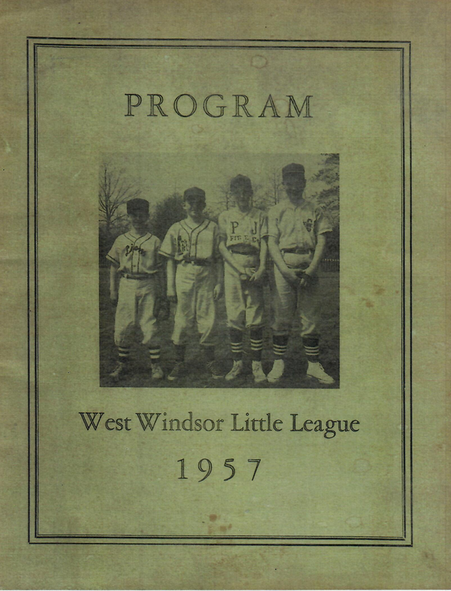 Click to read 1957 Yearbook!
Click to read 1957 Yearbook!
The West Windsor Newsletter (which took the place of a local WW newspaper at this time), December 1956 states, 'A serious effort is being made to bring Little League baseball to West Windsor Township. So far this effort has produced a field, built 1953/54, just north of the Alexander Road overpass made available by Conover and Emmons (lumber and hardware company in Princeton Junction, which eventually became Lucar Hardware), grading and seeding by the Township road crew, backstop materials donated by the Pennsylvania Railroad, rough seed donated by Conover and Emmons, and offers from others to help put the field in shape.'
In February of 1957, a franchise had been granted to West Windsor by the National Little League headquarters in Williamsport, PA and the first local Board of Directors had been elected. The first four teams were sponsored by: the West Windsor Lions Club, Princeton Junction Fire Company, the First National Bank of Princeton (at the time of this writing, United Jersey Bank) and the Penns Neck Community Club (a now-gone club dedicated to 'aid the civic, moral, intellectual and social welfare of the community' which operated from 1922 until the 1960s on Route 1).
Dedication! Memorial Day 1957! Ray Phillips, Commissioner, standing on the newly graded pitcher's mound before a packed house, opened the ceremonies with an introduction of each manager of the four teams, and then guest speaker, Ed McMilen, Captain of the Princeton University baseball team. Mayor Russel Mount threw out the first ball, and organized Little League Baseball was formally underway in West Windsor!
In February of 1957, a franchise had been granted to West Windsor by the National Little League headquarters in Williamsport, PA and the first local Board of Directors had been elected. The first four teams were sponsored by: the West Windsor Lions Club, Princeton Junction Fire Company, the First National Bank of Princeton (at the time of this writing, United Jersey Bank) and the Penns Neck Community Club (a now-gone club dedicated to 'aid the civic, moral, intellectual and social welfare of the community' which operated from 1922 until the 1960s on Route 1).
Dedication! Memorial Day 1957! Ray Phillips, Commissioner, standing on the newly graded pitcher's mound before a packed house, opened the ceremonies with an introduction of each manager of the four teams, and then guest speaker, Ed McMilen, Captain of the Princeton University baseball team. Mayor Russel Mount threw out the first ball, and organized Little League Baseball was formally underway in West Windsor!
In 1960, the League expanded to five teams with the introduction of C. Page Oil Company and American Cyanamid. Improved facilities for refreshments and for the general comfort of the spectators were provided. Tony Cusamano was responsible for the construction of the club house behind home plate. The two-story club house measured 10 ft by 10 ft with the refreshment standing downstairs and room for two people upstairs to keep score and to announce the action over the public address system.
This was also the first full year of operation for the Ladies' Auxiliary. The desire of fans to nibble on goodies had assumed proportions too great for informal preparations. The efforts and direction of Mrs. Lawrence Dey, Mrs. Jack Reed, Mrs. Sigmund Oleniczak and the experience of many others made the Auxiliary click from the very start, not to mention much-needed funds.
Two other sources of income were advertisements in the Yearbook produced from 1957 up into the 1970s, and the outfield fence advertisement signs. Most of the photos in this article come from various Yearbooks.
1962 brought Craft Cleaners to the League, and the introduction of the sixth team, the Cubs. Sponsorship of the last team was provided by 17 interested parents and some financial help from the Auxiliary. Thorne's Pharmacy became a team sponsor in 1964; that same year, the Cubs became the Ellsworth A.C.'s and the minor league was formed... but our story is not chronological.
This was also the first full year of operation for the Ladies' Auxiliary. The desire of fans to nibble on goodies had assumed proportions too great for informal preparations. The efforts and direction of Mrs. Lawrence Dey, Mrs. Jack Reed, Mrs. Sigmund Oleniczak and the experience of many others made the Auxiliary click from the very start, not to mention much-needed funds.
Two other sources of income were advertisements in the Yearbook produced from 1957 up into the 1970s, and the outfield fence advertisement signs. Most of the photos in this article come from various Yearbooks.
1962 brought Craft Cleaners to the League, and the introduction of the sixth team, the Cubs. Sponsorship of the last team was provided by 17 interested parents and some financial help from the Auxiliary. Thorne's Pharmacy became a team sponsor in 1964; that same year, the Cubs became the Ellsworth A.C.'s and the minor league was formed... but our story is not chronological.
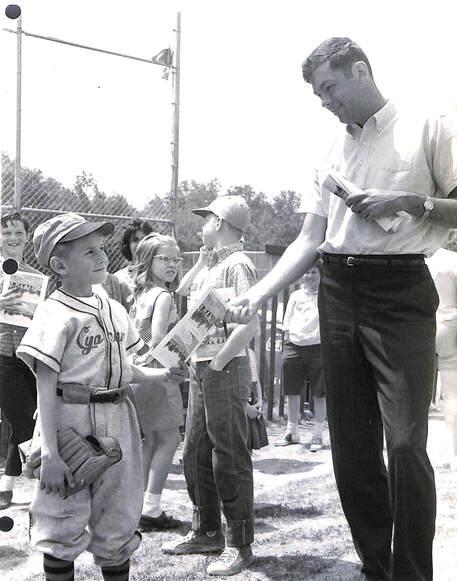 Bill Bradley visiting in 1963
Bill Bradley visiting in 1963
1962 was a banner year for the local League! The town was continuing to grow, and it was obvious that larger and even more complete facilities would be required if the needs were to be met. Even more excitement came with the visit of Bill Bradley, erstwhile NBA basketball player and three-term New Jersey senator, in 1963. Several photographs show excited fans shaking his hand and imploring him for autographs. Doubtless it was a memorable moment!
A friendly chat on the subject of Little League needs with a local landowner brought about 13 acres on North Post Road being purchased for Little League fields. With the help of many of those listed on the Honor Roll Plaque in the new club house, the field took shape during one summer, one fall, one winter... and frantically the next spring! Finally the new Richard J. Ward field was ready! New dugouts, equipment, and storage garage! Just about everything new - except the club house!
Tony Cusamano came through again with drawings for a new, greatly enlarged club house. Under the supervision of Sal Baldino, construction started almost before the final 1965 game was over - willing hands and borrowed equipment moved the old club house out of the way (intact for use at our proposed second field) and more willing hands and donated materials along long, long hours provided a new level foundation.
The 1966 season started on Monday, May 2; on the night of the first, there was much scrambling to finish the wiring, plumbing, installation of refrigerators, dugout telephones, and public address facilities. At dawn on the second, Dick Ward was moving the lawn and painting the scoreboard... and at 6 o'clock that evening, boys appeared in full uniform to play baseball!
A friendly chat on the subject of Little League needs with a local landowner brought about 13 acres on North Post Road being purchased for Little League fields. With the help of many of those listed on the Honor Roll Plaque in the new club house, the field took shape during one summer, one fall, one winter... and frantically the next spring! Finally the new Richard J. Ward field was ready! New dugouts, equipment, and storage garage! Just about everything new - except the club house!
Tony Cusamano came through again with drawings for a new, greatly enlarged club house. Under the supervision of Sal Baldino, construction started almost before the final 1965 game was over - willing hands and borrowed equipment moved the old club house out of the way (intact for use at our proposed second field) and more willing hands and donated materials along long, long hours provided a new level foundation.
The 1966 season started on Monday, May 2; on the night of the first, there was much scrambling to finish the wiring, plumbing, installation of refrigerators, dugout telephones, and public address facilities. At dawn on the second, Dick Ward was moving the lawn and painting the scoreboard... and at 6 o'clock that evening, boys appeared in full uniform to play baseball!
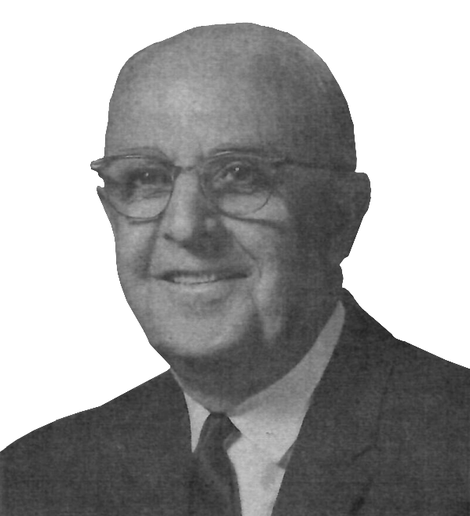 Richard J. Ward - from 1964 Yearbook
Richard J. Ward - from 1964 Yearbook
No historical commentary would be complete without a look into the future. During 1965 and 1966, work has begun on leveling, grading, and seeding a new playing field on the Little League property just south of the present field. As this is being written, the field is by no means ready for regular season play, and Dick Ward looks forward to continued efforts by fathers and friends of the League to prepare that field by next year. Additional landscaping is needed over much of the property, and if we are to keep pace with the growing population of West Windsor, we must anticipate the needs at least a year in the future.
In an editorial prefacing the 1958 yearbook, President Warren Froehlich wrote, 'the character building and physical benefits that our Little League offers our children, encourages all the people who devote so much time and effort to the program. The satisfaction we adults experience, and the excitement of Little League baseball that we all enjoy will be reflected in the spirit of our children, while acting as a constructive alternative to delinquency.'
In WW all was fairly calm. Girls could try out along with the boys and several were accepted. The concerns expressed turned out to be groundless. Stacey Godnick was the first girl to play major league LL as a regular team member. Other early girl Little Leaguers were Kimbra Layton, Loretta Gittens, Judy Guzy, Rochelle Stives, and Wendy Lockhart. All-girl teams were also begun in softball and baseball in the late 1970s.
In March 1974, a Gala Dinner was held to commemorate the final mortgage payment on the 13-acre R. J. Ward Field. At the dinner Roman Charydczak, who made the LL land available at extremely reasonable terms, was given a plaque for his support since 1961.
By 1974 there were three fields on the 13 acres. One of the fields was lit to allow games to go on until 9:30 p.m. The number of LL players had increased from 50 in 1957 to 300 in 1971."
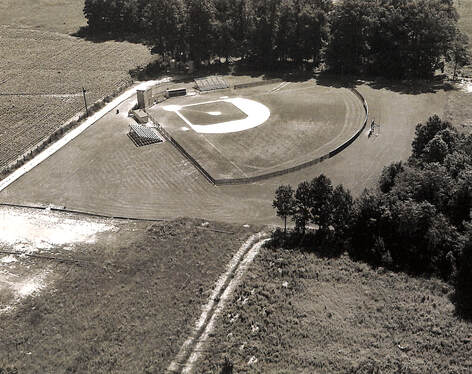 R. J. Ward Field
R. J. Ward Field
Highlights of the 1970s
The major highlights of the decade, according to Tony Manna, president from 1972 to 1975, were the inclusion of girls into LL, the final payoff of the mortgage on Ward Field, and the lighting of the field.
In 1973, the National Organization of Women (NOW) sued the national Little League for discrimination by not allowing girls to play on LL teams. NOW won the case, causing great upset in LL districts all over the country. There were unfounded fears of physical injury, antagonism against the girl players by the boys, and higher insurance rates. Some LL districts even suspended operation in protest. Yet, progress reigned.
During the 1970s and well into the 1980s, a major fundraising event was the Pancake Breakfast held each spring at the Christian Education Building of the Dutch Neck Presbyterian Church. Arnold Kelly described his designing of an enormous griddle to fit over the burners of the stove in the kitchen. During the 4 to 5 hours of the Breakfast, as many as 800 pancakes were made and eaten. An article in the West Windsor Plainsboro Chronicle of March 28, 1974 describes the menu of juice, coffee or milk, sausage, unlimited pancakes with melted butter and syrup for $1.75 per person ($1 for children under 12). However, by 1985, the cost went up to $3.50 per person.
Tickets for the Breakfast were sold by Little Leagues with prizes given to those selling the most. Registration for the League also took place during the breakfast for several years. The event was organized by the Ladies' Augiliary and involved almost all the League parents in one way or another.
The major highlights of the decade, according to Tony Manna, president from 1972 to 1975, were the inclusion of girls into LL, the final payoff of the mortgage on Ward Field, and the lighting of the field.
In 1973, the National Organization of Women (NOW) sued the national Little League for discrimination by not allowing girls to play on LL teams. NOW won the case, causing great upset in LL districts all over the country. There were unfounded fears of physical injury, antagonism against the girl players by the boys, and higher insurance rates. Some LL districts even suspended operation in protest. Yet, progress reigned.
During the 1970s and well into the 1980s, a major fundraising event was the Pancake Breakfast held each spring at the Christian Education Building of the Dutch Neck Presbyterian Church. Arnold Kelly described his designing of an enormous griddle to fit over the burners of the stove in the kitchen. During the 4 to 5 hours of the Breakfast, as many as 800 pancakes were made and eaten. An article in the West Windsor Plainsboro Chronicle of March 28, 1974 describes the menu of juice, coffee or milk, sausage, unlimited pancakes with melted butter and syrup for $1.75 per person ($1 for children under 12). However, by 1985, the cost went up to $3.50 per person.
Tickets for the Breakfast were sold by Little Leagues with prizes given to those selling the most. Registration for the League also took place during the breakfast for several years. The event was organized by the Ladies' Augiliary and involved almost all the League parents in one way or another.
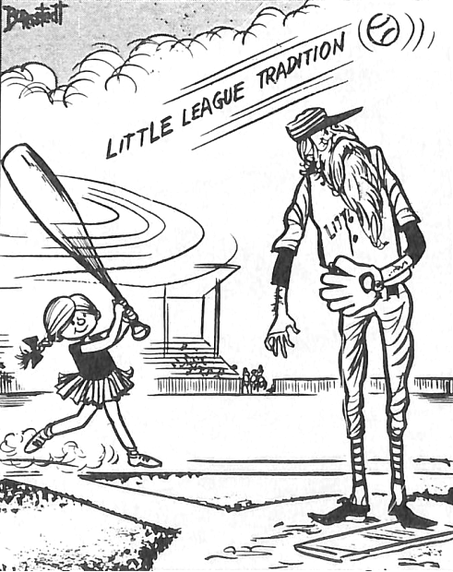 1974 Cartoon from Copley News Service
1974 Cartoon from Copley News Service
Teams' sponsors remained pretty much the same during the 1960s and 1970s. The 1968 summary listed: 1st National Bank since 1957; WW Lions since 1957; Craft Cleaners since 1962; Edinburg Hotel since 1967; Ellsworth's (formerly Princeton Junction Package Store) since 1963; and Thorne's Pharmacy (later Junction Pharmacy) since 1963. The 1971 Wasco Builders became a sponsor. Other 1970s sponsors included: Will's Shell and RCA.
During the 1980s, there were seven major league and seven minor teams in Little League. With a few changes, the major league sponsors were: Craft Cleaners, WW Lions, Lucar Hardware, RCA, Ellsworth's, Harbour Freight, and 1st National Bank (now United Jersey Banks).
The minor league teams were sponsored by: Beverage Barn, Grovers Mill Co., Nassau Savings & Loan, Hamilton Supply Co., Lanwin Builders, 3 Seasons (a sporting goods store), and P&W News (delivery service).
According to Joe Glassmacher, LL president during 1983-1984, 12 year old boys became the District All Star Champions in 1982. The WWLL girls' softball team won the District softball championship and were sent to regional play. Also, WWLL was the first to send 9-11 year olds to area regional tournaments.
During the 1980s, there were seven major league and seven minor teams in Little League. With a few changes, the major league sponsors were: Craft Cleaners, WW Lions, Lucar Hardware, RCA, Ellsworth's, Harbour Freight, and 1st National Bank (now United Jersey Banks).
The minor league teams were sponsored by: Beverage Barn, Grovers Mill Co., Nassau Savings & Loan, Hamilton Supply Co., Lanwin Builders, 3 Seasons (a sporting goods store), and P&W News (delivery service).
According to Joe Glassmacher, LL president during 1983-1984, 12 year old boys became the District All Star Champions in 1982. The WWLL girls' softball team won the District softball championship and were sent to regional play. Also, WWLL was the first to send 9-11 year olds to area regional tournaments.
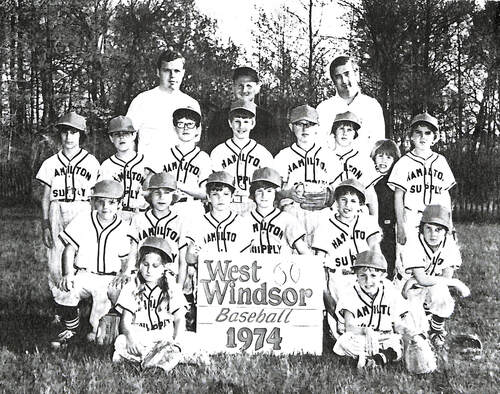
The major role of the Ladies' Auxiliary since its founding in 1959 has been raising funds to help support the LL's needs. As mentioned earlier, the refreshment stand at the fields provided much of the income. Since 1987, the refreshment stand/snack bar has been upgraded. Concern about the quality of well water at the field brought both Township water and a sewer hookup. Various equipment was purchased: ice-maker, french fryer, and soda fountain equipment to enable soda to be made, instead of using cans.
During the 1980s, LL players sold candy door-to-door to help raise funds for the games. This was replaced by raffle tickets which entitled the winner to a $1,000 gift certificate from a travel agency. These certificates were donated on alternative years by Premier Travel and Princeton Travel, both of which were also team sponsors. In the 1990s, the raffle continues with three prizes: a certificate to the Menlo Park Mall, tickets to a Phillies game and dinner at the Peacock Inn.
This year various apparel with the WWLL logo has been designed and is available at the concession stand during the season, as well as by mail order.
During the 1980s, LL players sold candy door-to-door to help raise funds for the games. This was replaced by raffle tickets which entitled the winner to a $1,000 gift certificate from a travel agency. These certificates were donated on alternative years by Premier Travel and Princeton Travel, both of which were also team sponsors. In the 1990s, the raffle continues with three prizes: a certificate to the Menlo Park Mall, tickets to a Phillies game and dinner at the Peacock Inn.
This year various apparel with the WWLL logo has been designed and is available at the concession stand during the season, as well as by mail order.
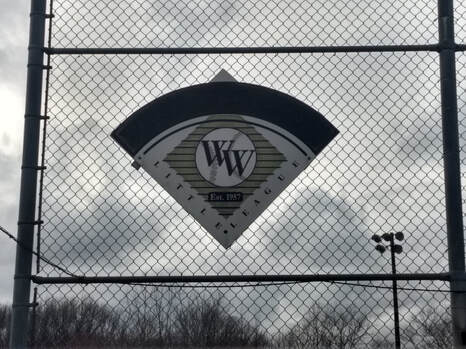
Little League in the 1990s
In 1994, there were 74 teams, some of them long-time sponsors. Boys and girls from 6 to 12 years could be part of Little League. The 6 and 7 year olds play T-ball in the Pony League. Those 8 year old and older began baseball in the Rookie League and are promoted to the Minor and Major leagues as their skills allow.
West Windsor's Little League is the only League in the district with a woman president, beginning with Nancy Guilbault in 1987, followed by Andrea Kelley in 1991-92 and Maggie Thiel, president in 1994. Also in 1994, there were different Coordinators at different levels with dealt with sponsors, equipment, and maintenance of the various teams.
In addition to Ward field, practice and games were played on four fields in the Conover Complex at Conover Road and South Post Road, as well as field at the West Windsor Community Park. These fields are used jointly by the West Windsor Township Recreational Department soccer teams and LL.
T-Ball was played at the Sarnoff field on Washington Road (it is interesting to realize that the Sarnoff fields saw the first local baseball games long before LL began). Work on the Ward fields continues. By 1995, it is hoped to have lighting on the third field in place. The Minor league field was lighted in 1993; the Major League also received new lights at that time.
In 1994, about 100 games were scheduled to be played, beginning in April and ending in June. This season was dedicated to the memory and spirit of Christopher Ciuffani, who tragically lost his life in an automobile accident the previous winter.
In 1994, there were 74 teams, some of them long-time sponsors. Boys and girls from 6 to 12 years could be part of Little League. The 6 and 7 year olds play T-ball in the Pony League. Those 8 year old and older began baseball in the Rookie League and are promoted to the Minor and Major leagues as their skills allow.
West Windsor's Little League is the only League in the district with a woman president, beginning with Nancy Guilbault in 1987, followed by Andrea Kelley in 1991-92 and Maggie Thiel, president in 1994. Also in 1994, there were different Coordinators at different levels with dealt with sponsors, equipment, and maintenance of the various teams.
In addition to Ward field, practice and games were played on four fields in the Conover Complex at Conover Road and South Post Road, as well as field at the West Windsor Community Park. These fields are used jointly by the West Windsor Township Recreational Department soccer teams and LL.
T-Ball was played at the Sarnoff field on Washington Road (it is interesting to realize that the Sarnoff fields saw the first local baseball games long before LL began). Work on the Ward fields continues. By 1995, it is hoped to have lighting on the third field in place. The Minor league field was lighted in 1993; the Major League also received new lights at that time.
In 1994, about 100 games were scheduled to be played, beginning in April and ending in June. This season was dedicated to the memory and spirit of Christopher Ciuffani, who tragically lost his life in an automobile accident the previous winter.
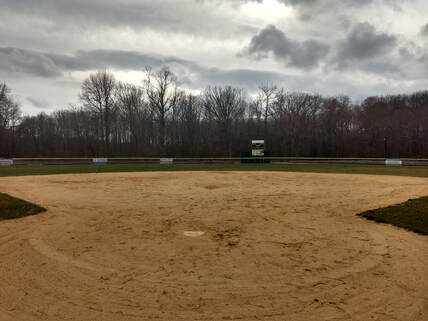 Play ball!
Play ball!
The 21st Century
As West Windsor continues to grow, so will its Little League. The fields are still popular destinations for youth, and at the R. J. Ward field, a brick sidewalk is lined with bricks commemorating families - some here, but many long gone - that made the dreams of youth possible for decades.
There is much more that could be said about the history of the LL, but space does not permit. However, the overall impression given by those involved is one of deep devotion to and joy in the game and its players. They are all committed to making certain that all those involved will be able to experience the sense of self worth, excitement, and satisfaction of learning teamwork, the skills of good sportsmanship, and the fun of baseball and softball.
Click on any of the images below to view one of the West Windsor Little League yearbooks from its first 18 years!
As West Windsor continues to grow, so will its Little League. The fields are still popular destinations for youth, and at the R. J. Ward field, a brick sidewalk is lined with bricks commemorating families - some here, but many long gone - that made the dreams of youth possible for decades.
There is much more that could be said about the history of the LL, but space does not permit. However, the overall impression given by those involved is one of deep devotion to and joy in the game and its players. They are all committed to making certain that all those involved will be able to experience the sense of self worth, excitement, and satisfaction of learning teamwork, the skills of good sportsmanship, and the fun of baseball and softball.
Click on any of the images below to view one of the West Windsor Little League yearbooks from its first 18 years!
